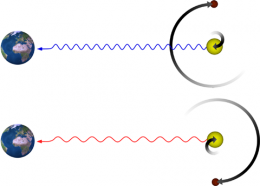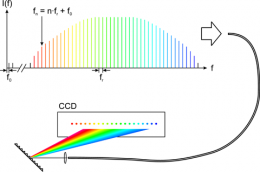May 31, 2012 report
Research team uses a laser frequency comb to calibrate spectrographs

(Phys.org) -- In the never ending quest to find out if there is life out there beyond our own planet, astronomers, astrophysicists and other researchers use all manner of tools to scan the sky looking for likely places; the most likely of course, being on a planet that is similar to our own. The problem thus far though, is that instruments used to look for so called exoplanets are relatively good at finding large planets that are close to their star, but not so much at finding those that are smaller, more rocky and more distant. That problem appears to be solved now though as a combined team of researchers from Germany and Spain have applied a new kind of calibration to spectrographs used to measure the wobble of stars due to planetary tugging. The team describes their work in their paper published in the journal Nature.
The primary means of finding exoplanets is through the use of spectrographs, instruments that separate waves of information into their different frequencies. Using them, researchers are able to detect the very subtle movement of a star when a planet comes near it, or departs. The result, described as a wobble not only alerts researchers to the presence of a planet, but gives up clues regarding its size, density and other properties. Up till now however, even the best spectrographs could only offer information about large Jupiter size planets that venture very near their star, causing a wobble strong enough to detect here on Earth.

In the new research, the team figured out how to use a laser frequency comb to calibrate a spectrograph to the extent that they were able to re-compute the orbit of the star HD 75289, which gave them more information about the planets that were circling it. A laser frequency comb is a device that emits a series of evenly spaced spectral lines that resemble the teeth on a comb. It’s as stable and accurate as an atomic clock, which means spectrographs that are calibrated using it are far more precise than anything used up till now. The end result of implementing this new technique should be the discovery in coming years, of more and more exoplanets that are smaller, cooler and farther from their star; much more like our own, perhaps one day leading to the discovery of one, that like ours, holds life.
More information: A spectrograph for exoplanet observations calibrated at the centimetre-per-second level, Nature 485, 611–614 (31 May 2012) doi:10.1038/nature11092
The best spectrographs are limited in stability by their calibration light source. Laser frequency combs are the ideal calibrators for astronomical spectrographs. They emit a spectrum of lines that are equally spaced in frequency and that are as accurate and stable as the atomic clock relative to which the comb is stabilized. Absolute calibration provides the radial velocity of an astronomical object relative to the observer (on Earth). For the detection of Earth-mass exoplanets in Earth-like orbits around solar-type stars, or of cosmic acceleration the observable is a tiny velocity change of less than 10 cm s−1, where the repeatability of the calibration—the variation in stability across observations—is important. Hitherto, only laboratory systems or spectrograph calibrations of limited performance have been demonstrated. Here we report the calibration of an astronomical spectrograph with a short-term Doppler shift repeatability of 2.5 cm s−1, and use it to monitor the star HD 75289 and recompute the orbit of its planet. This repeatability should make it possible to detect Earth-like planets in the habitable zone of star or even to measure the cosmic acceleration directly.
Journal information: Nature
© 2012 Phys.Org




















